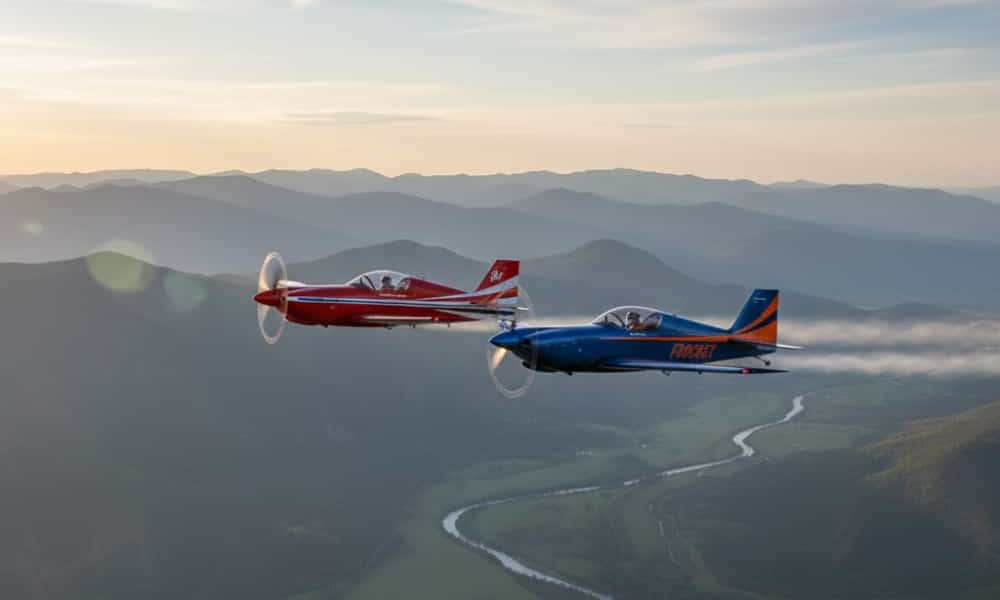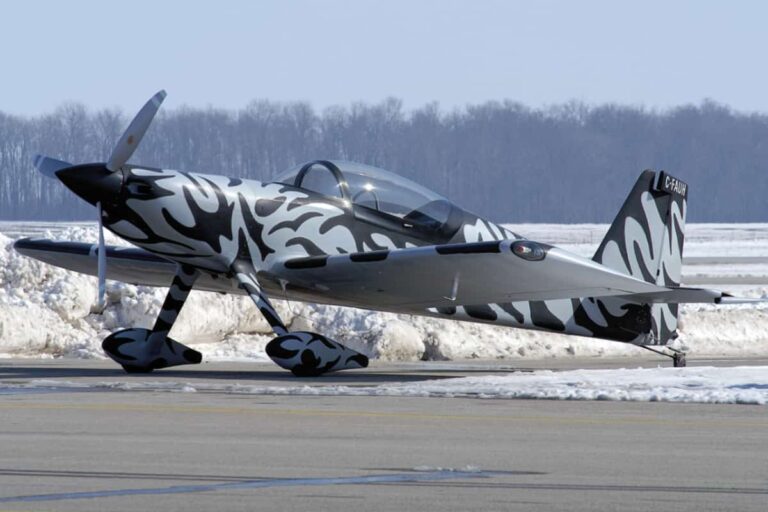The F1 Rocket airplane stands as one of aviation’s most thrilling homebuilt aircraft. This speed demon offers performance that rivals factory-built warbirds. Pilots who fly it describe an experience like nothing else in general aviation. Let me take you inside this remarkable machine.
What Makes the F1 Rocket Airplane Special?
Team Rocket manufactures the F1 Rocket as a kit aircraft. Builders construct it themselves under experimental aircraft regulations. This isn’t your typical weekend flyer.
The F1 Rocket delivers fighter-like performance in a civilian package. It climbs at rates exceeding 3,000 feet per minute. Cruise speeds top 230 mph at 75% power. Some pilots report maximum speeds reaching 253 mph.
The aircraft features all-aluminum construction. It sits on titanium fixed landing gear with a tailwheel. Two people fly in tandem configuration. The design prioritizes speed and climb performance above all else.
Mark Frederick developed the F1 Rocket in the early 2000s. He wanted a stand-alone kit that didn’t require parts from other manufacturers. The prototype first flew in November 2000. By 2003, seven more aircraft were flying. Over 130 F1 Rockets had taken to the skies by late 2017.
Vince Frazier now owns Team Rocket through Frazier Aviation Products LLC. He operates from Indiana and continues supporting builders worldwide.
F1 Rocket Airplane Specs: Built for Speed
The numbers tell an impressive story.
Physical Dimensions:
- Length: 21 feet
- Wingspan: 21 feet 6 inches
- Wing area: 106 square feet
- Empty weight: 1,199 pounds
- Maximum takeoff weight: 2,000 pounds
Engine Options: The F1 Rocket accepts engines between 235 and 350 horsepower. Most builders choose the Lycoming IO-540 with 250-350 HP. Some opt for the Continental IO-550. A six-cylinder Lycoming with a three-bladed propeller represents the most common configuration.
Fuel Capacity: Standard tanks hold 42 gallons total. Long-range tanks extend capacity to 55 gallons. This gives the aircraft approximately 1,150 statute miles of range depending on configuration and power settings.
The wing uses a rectangular planform on standard models. The discontinued Evo wing featured a tapered design with different aileron and flap systems. Team Rocket is developing a new tapered F-wing variant expected in early 2025.

F1 Rocket Airplane Top Speed and Performance
Speed defines this aircraft. Pilots regularly see 230 mph cruise speeds at 75% power. The never-exceed speed hits 240 knots. Some builders have pushed their aircraft to 253 mph maximum speed.
Real-world cruise performance impresses even more. One owner reports 202 knots true airspeed while burning just 11.8 gallons per hour. At economy cruise settings of 10,500 feet, pilots achieve 220 mph true airspeed on only 10.5 gallons per hour.
The supercharged version built by former Luftwaffe pilot Wolfgang Meyn achieves 220 knots true at 17,500 feet. It sips just 12.5 gallons per hour running lean of peak.
Climb Performance: Standard F1 Rockets climb at rates exceeding 3,000 feet per minute. The supercharged version achieved 4,000 feet per minute at 37 inches manifold pressure and 2,600 rpm.
Pilots describe the takeoff and climb as astounding. They don’t worry about density altitude, runway length, or gross weight. If there’s enough room to land without damage, the F1 Rocket will definitely get back out.
The stall speed sits at 48 knots with the fat airfoil providing benign stall characteristics.
F1 Rocket Cruise Speed: Economy Meets Performance
Here’s where the F1 Rocket surprises people.
Many assume a 230 mph airplane guzzles fuel. The reality differs dramatically.
Typical fuel burn runs just 9 gallons per hour at 160 knots. This matches the consumption of a 160 HP RV-6. Throttle back to match RV speeds and the F1 burns similar fuel while keeping massive power in reserve.
One pilot compared his stable directly:
- RV-8: 165 knots true at 8.5 gallons per hour (19.4 miles per gallon)
- F1 Rocket: 202 knots true at 11 gallons per hour (18.3 miles per gallon)
The fuel economy remains nearly identical. The speed advantage? A massive 37 knots.
Full-power comparison shows:
- RV-8: 178 knots at 17.5 gallons per hour
- F1 Rocket: 220 knots at 25 gallons per hour
The F1 delivers 42 additional knots for 7.5 extra gallons per hour.
Insurance costs run higher than RVs due to the higher hull value. Maintenance expenses mirror other six-cylinder Lycoming installations. The titanium gear legs require little upkeep but cost over $4,000 per pair if replacement becomes necessary.
Harmon Rocket vs F1 Rocket: Understanding the Differences

These aircraft share heritage but differ significantly.
John Harmon created the original Harmon Rocket by modifying an RV-4 kit. Builders purchase RV-4 parts from Van’s Aircraft, then add the Harmon Rocket II conversion kit. The two sets of parts must be matched and fitted together. Nothing comes pre-punched.
Mark Frederick designed the F1 Rocket as a stand-alone kit. No Van’s parts required. The kit arrives more complete with many components already drilled.
Key Structural Differences: The F1 includes a sliding canopy as standard. The Harmon Rocket typically uses a tip-over canopy. The F1 features titanium gear legs, larger brakes, and beefier structures in critical areas. The firewall is widened and tail surfaces are larger.
Landing gear geometry differs too. The F1 moved the main landing gear axle centerline forward approximately 2 inches. This reduces the tendency to nose over during hard braking.
Fuel Capacity: The F1 holds 52 gallons of fuel. The Harmon Rocket II carries 42 gallons. This gives the F1 significantly better range.
Performance: Speed differences depend primarily on build quality. Minimal practical difference exists between well-built examples of each. One group of six Rocket pilots includes three F1s and three Harmon Rocket IIs. One F1 flies fastest, followed closely by a Harmon Rocket II. The rest show no practical difference.
Build Complexity: The Harmon Rocket II requires matching parts from two manufacturers. This demands more builder skill and experience. The F1 offers a more complete quickbuild kit with pre-punched components. First-time builders typically find the F1 easier to construct.
Both aircraft deliver exceptional performance. The choice often comes down to builder experience and personal preference.
F1 Rocket vs RV-8: The Performance Gap

The RV-8 represents one of Van’s most popular designs. How does it compare to the F1 Rocket?
Speed Advantage: The F1 Rocket cruises 35-40 knots faster at comparable fuel efficiency. At typical cruise settings, the RV-8 delivers 165 knots true on 8.5 gallons per hour. The F1 Rocket achieves 202 knots true on 11 gallons per hour.
The F1 nearly doubles the RV-8’s rate of climb.
Interior Space: Cockpit interior room runs very close between the two. Luggage capacity is similar even though the RV-8 has two baggage compartments. The F1’s rear baggage compartment is actually cavernous compared to the RV-8. It extends way back to an additional bulkhead.
The RV-8 offers more headroom. The F1 provides more width. Seating position differs – you sit down into the F1 where you feel more upright in the RV-8. The F1 instrument panel sits 3-4 inches further from your eyes, making the pilot’s office seem roomier.
Cost Difference: The F1/F4 airframe costs about 20% more than a similar RV-8 airframe. The titanium landing gear set exceeds $4,000 per pair – a significant single cost difference.
Canopy kits show the disparity. Slider canopies cost about $4,200 while floppers run about half that price.
Practical Considerations: One pilot who owned both aircraft for years provides perspective. His typical mission was a 400 nautical mile trip. Hangar to hangar, the RV-8 with 200 HP fuel injection and constant speed prop took only 15-20 minutes longer than his 260 HP F1 Rocket.
He loved the F1’s performance but found comfort became an issue after the two-hour mark. Getting out required several minutes of pure agony as he aged. The RV-8 allowed easy three-hour flights with comfortable exit. The RV-8 also delivered significantly greater baggage capacity for practical travel.
His advice? If speed thrills you and you’re younger and smaller, the F1 Rocket delivers unmatched excitement. For practical cross-country travel with maximum comfort, the RV-8 makes more sense.
Read Also: Average Speed of Fighter Jets
Team Rocket F1 Rocket Performance: Real Pilot Experiences
Owners describe the F1 Rocket as addictive. One builder who flew aircraft #3 for seven years called it “nice performance.” He noted the only way to do better requires a composite aircraft. He eventually sold it because his wife didn’t like tandem seating and they needed a Bonanza for family travel.
Another pilot describes rides in the aircraft: “If you take a ride and aren’t instantly hooked, seek professional help immediately.”
The maneuvering speed (Va) sits at approximately 125 knots. Pilots report sporty feel with light, smooth controls. Ground handling remains predictable despite the tailwheel configuration.
The aircraft handles turbulence better than you’d expect. Higher wing loading compared to the RV-8 cuts through chop without abusing the pilot. Many pilots far prefer how the Rocket flies through rough air.
Roll rate exceeds the RV-8. Vertical performance stands superior. The benign stall characteristics and fat airfoil inspire confidence during slow flight.
Not a Beginner’s Airplane: The F1 Rocket requires proper airmanship and energy management. It’s not a forgiving trainer. Pilots must respect the aircraft’s capabilities and stay ahead of it during approaches.
Wolfgang Meyn, the former Luftwaffe F-104 and Tornado pilot, calls flying his supercharged F1 Rocket pure joy. He alternates between ebullient and enthusiastic when discussing the aircraft.
F1 Rocket Evo Wing: The Advanced Performance Option
Team Rocket developed the Evo wing as an evolutionary variant. The tapered wing design replaced the rectangular wing found on standard F1 models. Significant changes were made to aileron and flap design. The wing utilized the MS(1)-313 laminar airfoil developed by NASA.
Performance improved noticeably. The Evo wing delivered approximately 10 mph speed advantage over the Sport wing. It created a better IFR platform and proved easier to handle in instrument conditions.
Trade-offs existed. The standard wing weighs approximately 70 pounds less than the Evo wing. It also offers greater center of gravity range – important for loading flexibility.
Current Status: The Evo wing is no longer available. Production stopped years ago. Team Rocket is actively working on a new tapered wing design called the F-wing. It’s currently in prototype construction phase with expected availability in early 2025.
No guarantees exist that the new F-wing will reach production. Vince Frazier emphasizes they are working on it but makes no promises.
F1 Rocket Airplane Price: What Does It Cost?
Building an F1 Rocket requires significant investment.
Kit Component Pricing:
- Slider canopy kits: approximately $4,200
- Flopper canopy kits: approximately $2,100
- Titanium landing gear legs: over $4,000 per pair
- Complete finishing kits: fully available with all fiberglass parts
Historical complete quickbuild kits cost around $30,000-$50,000 when available. Current pricing requires contacting Vince Frazier directly for quotes.
Total Build Cost: Expect to invest well over $200,000 for a completed aircraft with all systems. This includes:
- Airframe kit and components
- Engine (IO-540 or IO-360 cost similar on used market)
- Propeller
- Avionics and electronics
- Interior materials
- Paint and finishing
- Countless hours of builder time
One builder with extensive customizations reported over 3,000 hours to complete his aircraft. Another mentioned building took longer than expected even with the quickbuild kit.
F1 Rocket for Sale Market: Used aircraft market remains limited due to the niche nature. Typical asking prices range from $150,000 to over $300,000 depending on equipment and condition.
A brand-new F1 Rocket with 60 hours total time recently listed at $305,000. It featured stunning five-color paint, leather interior, IO-540 engine, dual SDS EFII systems, and full Garmin glass panel with G3X, GNC255, and related equipment.
The aircraft holds value well compared to other homebuilts. Strong performance and limited production create steady demand among enthusiasts.
F4 Raider: The Four-Cylinder Alternative
Team Rocket offers the F4 Raider for builders wanting lighter weight and lower operating costs.
The F4 uses the same fuselage as the F1 Rocket. The key difference? A four-cylinder Lycoming parallel valve engine producing 180 to 200+ horsepower instead of the six-cylinder powerplant.
Performance Comparison: F4 Raider performance proves comparable to an angle-valve RV-8, possibly better. Cruise speed drops only 4 mph from the IO-540 equipped F1. Fuel burn reduces by 3.8-4 gallons per hour – significant savings over time.
The aircraft weighs 150 pounds less empty than the F1. This improves handling characteristics and creates a lighter feel on the controls. Higher wing loading gives great handling while modern four-cylinder engines close the performance gap with the big brother.
Several F4s now fly regularly. Builders report speeds matching or exceeding published specifications. Ray Ward, Brad Hood, and Larry Vetterman fly the first F4s and love them.
The F4 makes sense for pilots who want Rocket performance without six-cylinder operating costs. It delivers outstanding capability with more economical operation.
Building Your F1 Rocket: What You Need to Know
Building an F1 Rocket challenges even experienced builders.
Builder Requirements: Team Rocket’s ideal customer has built one or more airplanes previously. First-time builders need a tenacious streak to succeed. The kit isn’t pre-punched like modern Van’s kits, requiring more fitting and drilling work.
You’ll need RV-4 plans for fuselage construction reference. Harmon Rocket II plans prove very useful. Both are available from their respective companies. The RV-4 preview set comes highly recommended.
Build Time: Plan for substantial time investment. One builder reported over 3,000 hours including customizations. The “quickbuild” kit still requires plenty of work despite the name. You’ll assemble the airframe, install the engine, complete all wiring and plumbing, fabricate the interior, and handle painting.
Parts Sourcing: Unlike complete kits from some manufacturers, building an F1 Rocket requires sourcing parts from multiple vendors. Wings typically come from RV-4 kits or Team Rocket’s partial wing kit. The empennage uses Team Rocket’s Mk3 design – strongly recommended for best results.
Current Kit Availability: Team Rocket ships fuselage parts, finishing kits, and updated empennage components. All necessary fiberglass parts, wingtips, cowlings, and fairings are available. A new round inlet cowling recently became available.
The new tapered F-wing remains in prototype construction phase. Contact Vince Frazier at f1aircraft.com for current parts availability and pricing.
Builder Support: Team Rocket maintains extensive documentation. The website hosts original builder’s manuals, updated builder’s manuals, task-specific PDFs, blank weight and balance spreadsheets, blank POH documents, builder photos, newsletters, exploded parts diagrams, and other useful information.
Every builder must familiarize themselves with these resources. Every owner should refer to this information when questions arise.
Networking with other builders helps tremendously. The Team Rocket forum provides community support. Your local EAA chapter, especially members with RV building experience, can offer valuable assistance.
Is the F1 Rocket Airplane Right for You?
This aircraft demands serious consideration.
Ideal Candidates: The F1 Rocket suits experienced builders seeking maximum performance. It appeals to pilots prioritizing speed and climb rate above all else. Cross-country flyers wanting 230+ mph cruise speeds find it irresistible.
You should be comfortable with higher operating costs compared to smaller engines. The six-cylinder Lycoming requires more maintenance and burns more fuel at full power. Insurance premiums run higher due to increased hull values.
Key Considerations: Building complexity exceeds modern pre-punched kits. Plan for substantial shop time and problem-solving. Limited baggage space compared to side-by-side aircraft may affect utility for some missions.
The tandem seating arrangement doesn’t suit everyone. Your passenger sits behind you with limited forward visibility. Getting in and out requires more flexibility than side-by-side aircraft.
Taller pilots may find the cockpit snug. One 6’5″ pilot found the RV-8 more comfortable despite the F1 being 4 inches wider. Headroom and legroom require careful consideration for larger individuals.
The Rewards: Owners consistently describe the F1 Rocket as the most exciting aircraft they’ve flown. The exceptional performance-to-weight ratio delivers experiences few other homebuilts can match.
Active builder community and ongoing manufacturer support provide confidence. Team Rocket continues shipping parts and developing improvements. Several new aircraft flew in 2023, including Airventure Lindy award winners.
The aircraft holds value well in the used market. Strong performance and limited production create consistent demand.
Read Also: F-16 Ride Along
F1 Rocket Airplane: Frequently Asked Questions
How much does an F1 Rocket airplane cost?
Kit components range from $30,000-50,000 for the airframe. Completed aircraft total $150,000-300,000+ depending on engine, avionics, and finishing quality. A brand-new example with premium equipment recently listed at $305,000.
What is the F1 Rocket top speed?
Maximum speed reaches 253 mph with typical cruise speeds of 230 mph at 75% power. Real-world performance varies by build quality and engine configuration.
F1 Rocket vs RV-8 – which is faster?
The F1 Rocket cruises 35-40 knots faster than the RV-8. Typical numbers show 202 knots true for the F1 versus 165 knots true for the RV-8 at similar fuel consumption rates. The F1 also delivers double the climb rate.
What’s the difference between Harmon Rocket and F1 Rocket?
The F1 is a stand-alone kit requiring no RV parts. It features titanium gear, larger fuel capacity (52 versus 42 gallons), sliding canopy, and comes more complete with pre-punched components. The Harmon Rocket II uses RV-4 base parts plus conversion kit with tip-over canopy and less pre-drilled components.
Is the F1 Rocket kit for sale?
Team Rocket currently ships fuselage parts, finishing kits, and empennage components. Complete quickbuild kits are not regularly available. Contact Vince Frazier at f1aircraft.com for current parts availability and custom quotes.
What is the F1 Rocket cruise speed?
Typical cruise speed runs 230 mph at 75% power. Economy cruise delivers 220 mph true airspeed at 10,500 feet burning just 10.5 gallons per hour. Pilots can throttle back to 160 knots burning only 9 gallons per hour when flying with slower aircraft.
Final Verdict: The F1 Rocket Airplane Experience
The F1 Rocket airplane represents the pinnacle of homebuilt performance.
It outclimbs virtually everything in general aviation. It cruises faster than most factory-built singles. It delivers fuel economy comparable to aircraft 40 knots slower.
Building one requires skill, patience, and significant investment. Flying one demands respect and proper training. Owning one means accepting higher operating costs and insurance premiums. The rewards? Pure aviation joy.
Pilots describe climbs so powerful they stop worrying about density altitude or runway length. They talk about effortlessly cruising at 230 mph while sipping fuel. They rave about the confidence-inspiring handling and benign stall characteristics.
The F1 Rocket isn’t for everyone. It shouldn’t be. This aircraft caters to serious pilots who want maximum performance and are willing to work for it.
For those willing to invest the time and resources, the F1 Rocket delivers fighter-like capabilities in a civilian package. It’s a time machine that turns weekend trips into quick hops. It’s a magic carpet that makes distant destinations suddenly accessible.
More than anything, it’s a reminder of why we fell in love with flying in the first place. The freedom. The speed. The pure, unfiltered joy of flight. That’s what the F1 Rocket airplane delivers. Every single time. Fore more information, visit Crew Daily.


